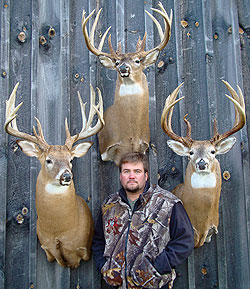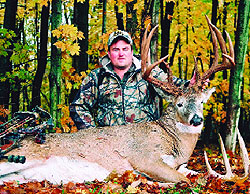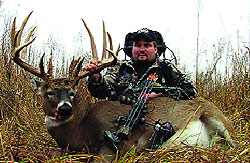September 22, 2010
This avid Ohio bowhunter has had incredible success hunting the last 10 days in October. You can, too, if you'll heed this advice.
 : The author is one of the few bowhunters in North America who have taken three bucks that gross over 200 inches. His hard-hitting strategy is no doubt the reason why he has been so successful! (Bottom left) This 202-inch bruiser was taken in Franklin County, Ohio, in 1999. (Top) This Ohio hawg was taken in Fairfield County in 2006. It grossed 208 3/8. (Bottom right) Adam's third 200-incher grossed 202 2/8 and was also taken in Franklin County in 2003. |
As I hung up my bow and settled into my stand for an evening hunt, I quietly let out a sigh of relief. A westerly breeze was blowing in the first real cold front of the season, and I was hoping the wind had covered up any sounds I'd made hanging my stand. The night before, I had watched a giant 200-inch whitetail emerge from the thin strip of trees I was now in. The trees separated a picked cornfield from a CRP field.
It was only the third time I'd laid eyes on the buck since January, and he finally had made a mistake. Not a day had gone by since I filmed him nine months ago that I hadn't thought about his huge rack. I spent three months looking everywhere for his sheds and all summer glassing for him in soybean fields, and nothing! I wasn't sure he was still alive until Oct. 13, when he passed by me at 90 yards while I was in a different stand.
Advertisement
At last light the day before, I had watched him 300 yards away. He picked through the corn stubble not 30 yards from the tree I was now sitting in. If he did the same thing tonight, he'd be in bow range. I watched the CRP field for the next hour and daydreamed about the big buck. Then something caught my eye. I raised my binoculars and focused on the spot. It was him! He had just stood up from his bed about 80 yards out, and he was heading my way!
OCTOBER BONANZA
I know countless articles have been written about how all the biggest bucks are taken during the rut. The only drawback is that a rutting buck can be anywhere at any time during this period. And a hot doe could lead a mature buck miles from where you might be hunting for him. I honestly believe the best time to kill a specific buck is before the rut.
Advertisement
I spend untold hours scouting and glassing fields every year to find a big buck to hunt. After I find one, I learn everything I can about that particular animal. I've had great success over the past 16 years harvesting bucks during the early season, especially the latter part of October. In fact, my three biggest bow kills have all been taken during the last 10 days of October. All of those bucks gross-scored over 200 inches. You can understand why October is my favorite time to hunt. If you follow my pre-rut strategy, I believe your odds for tagging a trophy whitetail during the early season will go up dramatically.
FIND THE BUCK YOU WANT TO HUNT
It doesn't matter if you're the best hunter in the world, if there isn't a big buck in the area where you are hunting, you can't kill one. Period! It doesn't matter if your goal is to shoot a 125-inch buck or a 225-incher -- if he's not there, you're wasting your time. You must find the buck you want to harvest. I knew where all three of my biggest bucks were living because I dedicated seven years to finding and hunting those deer.
 If you want to get serious about taking a bruiser buck like this 202 2/8-inch giant, Adam believes, you first have to locate a buck that you want to hunt and then find his core area. Then you have to set up on him without tipping him off. |
Shed hunting is my first step in locating a mature buck. If you find a good set of antlers, then you know the buck survived the hunting season. Sheds also give you a starting point to figuring out a buck's home range. At this time, which is usually in the spring, I try to learn as much as possible from the sign the buck left behind, especially big rubs. Rubs give you clues to the buck's travel patterns, and concentrations of big rubs can lead you right to his bedroom.
If I can't locate big sheds, the best time of the year to actually lay eyes on a mature buck is during the summer, and the best place is in soybean fields. I have spotted almost every big buck I have harvested by glassing soybean fields during the summer. Big bucks are relaxed and more apt to move during daylight in the summer, and if you have soybeans in your area bucks will surely be feeding on them. However, not every bean field is going to hold a mature buck, and bucks can be hard to spot months before the season opens.
I look for secluded fields not visible from the road. Even in these remote spots, a mature buck may not show himself every night as younger bucks do. I spent over 50 evenings in the summer of 2003 trying to get footage of the second 200-inch buck I killed, but he only showed himself three times before dark.
I prefer to set up a stand a few hundred yards away while observing deer in the summer. This lets me note what trails the buck uses to enter and exit the field, and what the corresponding wind direction is. Trail cameras placed along the field edges can also help you keep tabs on his movements when you're not there, and after dark. There are certain days of the month, even in the summer, that give you your best chance of seeing a mature buck during daylight, and I'll discuss that topic later.
SWITCHING GEARS
At summer's end, there are definitely going to be some changes taking place that you need to keep in mind. When a buck sheds his velvet in early September, he'll become very reclusive. There's a chance that he may continue using the same food source he has been in all summer, but he may also leave the area completely. A great way to tell if he's left the area or if he's just become more nocturnal is to set up a trail camera along the path he's been using entering and exiting the field. If he's still around, he'll also be leaving fresh sign behind, and big rubs let me know he's still close. Remember, food is still a high priority, and bean fields that are still green at this time, along with acorns that are beginning to drop, are key early locations.
A buck's core area can be close to the field you've been watching all summer, but it could also be a good distance away. If he disappears completely, he has probably vacated the area and relocated to his core area at this time. His No. 1 concern right now is going to start changing from food to security. Food is still high on the list, and you might have to do some legwork to locate him. I start by checking other preferred food sources. It
's best if you can still watch a food source from a distance to try to locate your buck at this time. If this doesn't work, you may have to do some low-impact scouting.
 This 208 3/8-inch heavyweight, taken in 2006, was Adam's most recent 200-incher -- and it did not come easy. Adam likes to hunt the wind so that it's in the buck's favor. Even though this is tricky, it can be done so that the hunter is not detected until the very last second. |
This is when the information found while shed hunting really comes into play. The areas that held the highest concentration of big rubs are good places to start looking. Chances are good that he has moved to his favorite area of security cover and will be leaving lots of fresh rubs behind! By scouting these areas now, you are taking a chance on bumping a buck out of his bedding area, but I'd rather do that than waste my time hunting in the wrong spot. Even if you bump him, he probably won't leave the county and he'll likely return to this spot. He is bedding in that spot for good reason, and if not harassed, he will be back!
SOLVING THE PUZZLE
Whether it's spring shed hunting, summer velvet watching, or early season scouting, all three steps give me crucial pieces to the puzzle and help me look at the big picture. What I'm trying to accomplish through all this work is to establish three things: 1)€‚a buck's core area; 2)€‚his preferred food source; and 3)€‚the way he gets from one to the other.
This might seem very basic, but when you consider the variables that are changing during the early season -- summer areas to core areas, changing food sources and hunting pressure -- it can actually be quite a task knowing exactly what a mature buck is doing and where he is doing it. Plus, at this time of the year he is actually moving less than at any other time of the season. In order to be able to harvest a buck early, you have to be right on top of him!
The good part about the early season is that he is going to be doing the same basic things daily -- mainly, eating and sleeping! If you know where he sleeps and where he eats, and if you have a good idea of how he gets back and forth, you can kill him. The only questions still needing answers are exactly where and when.
THE "WHERE"
If I have a good idea where a buck is bedding and feeding, the next step is to figure out how he gets back and forth and then find the best spot along this path for a stand. A buck is going to be leaving behind plenty of sign right now -- rubs, scrapes, tracks -- and these are all important clues to let you know his preferred travel pattern. Setting up trail cameras along these paths can also be very helpful in letting you know if it's the particular buck you're after. This is rather basic, but once you've established his travel pattern you need to go one step further. This is what I refer to as finding his weak spot, or the where.
What I'm looking for specifically is a spot along a buck's travel pattern where I can get within bow range of him while he is using the wind to his advantage! This is very important. A mature buck will almost always be using the wind to some degree if he's moving during daylight. Otherwise, I believe, he'll stay bedded down until dark. When a buck is using the wind, he's comfortable moving, so the chances of him moving during daylight hours are in your favor at this time. The challenge is to put yourself in a spot where the wind is good for both of you simultaneously.
It can be tough when a buck is traveling in a straight line with the wind in his face, so look for spots where he has to make a turn or change his direction of travel. Funnels or pinch points that force a buck through a specific area are great also. The closer this spot is to his bedding area is, the better off you'll be! If all else fails, I'll pick a spot where he can't wind me until he is within bow range. By that time my arrow will already be on its way.
I prefer to be close enough so that he can hear some soft calling but far enough away so that I can access my stand without tipping him off as to my presence. This is a great time to mention this also: Stalk your stand! There is no sense in going through all this work if you're going to spook deer on the way into your stand. Take the extra time for a quiet approach and go out of your way if need be to keep from alerting deer in the area.
THE "WHEN"
The last part of this strategy is the easiest to distinguish but the hardest to put into practice. This is waiting for the right time to move in for the kill. If you've thoroughly scouted the big buck you've found, you should know where he beds, his travel patterns, his preferred food sources and the best stand site for killing him. Once you have all that figured out, the hardest thing to do is to wait days or even weeks before hunting that spot. Why some hunters go through all the preliminary work only to go in when the conditions aren't perfect is beyond me. You may only get one crack at a mature buck. Don't blow it by rushing in under the wrong conditions and spooking him. If you do, the game's over. I make sure that three main factors are in my favor before I go in after a trophy buck.
The first variable is the wind. I know exactly which wind direction I'm waiting for. It'll be the one that's good for both the buck and me and the one that he feels comfortable enough with to get up before dark and start heading for food during daylight.
Number two is the buck's demeanor. Toward the end of October bucks get anxious. It's almost like they are looking for an excuse to get up early. Their testosterone is building, they are getting aggressive and they are becoming more interested in does. Best of all, at this time they still follow very predictable daily patterns.
The third and final key is the moon. There are a few days in late October when the moon peaks in the sky during prime evening hours. These "red days" are by far the best for mature bucks on a strict bedding-to-feeding pattern to be up and moving before dark. I have paid close attention to the moon guide for close to 10 years, and it's right on the money. When I spoke earlier of waiting 50 nights during the summer to get footage of my second 200-inch buck, the only nights he showed up in the field before dark were on the red days on my chart.
When I do finally move in when all conditions are perfect, I do some light rattling just prior to sunset. I want the buck to hear me while he is still bedded. It's the icing on the cake. He's primed for it, and at this time it usually pushes a mature buck right over the edge. I believe it's easier to get a buck to come your way if he isn't already up and moving in another direction. I harvested all three of my 200-inch bucks during these last 10 days of October when the wind and the moon were in my favor. It's a deadly combination!
CONCLUSION
As I watched the giant buck coming through the high weeds, I couldn't believe my eyes, or the size of his rack. If he contin
ued on his course, he was going to emerge from the CRP out of bow range. I started to get a little nervous that I might not get a shot. When he reached the hedgerow, he stopped and looked my way, but past me. He was at about 80 yards out and I needed him to turn and come my way. He kept staring down the edge of the field as if watching another deer. It seemed like he stood there forever, staring.
It was everything I could do to keep my composure. "Come on, baby, turn my way," I said to myself. Then, as if on cue, he did. As he began cutting the distance, I focused my video camera on my only shooting lane and waited. When the giant was almost directly in front of me, a tree between us allowed me to bring my Lobo (a Lone Wolf prototype) to full draw. As he stepped into my shooting lane, I grunted. The giant stopped and turned my direction. As my pin settled in right behind his shoulder, I squeezed my release and watched as my Lumenok disappeared right where I was aiming!
(Editor's Note: The author is the producer of the popular TV show "Whitetail Addictions." To buy the DVD showing the hunt for his third 200-inch Ohio buck, go online to www.whitetailaddictions.com.)
